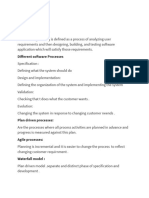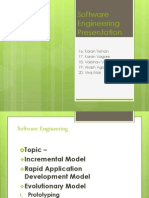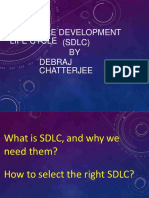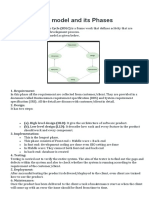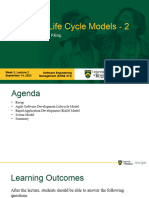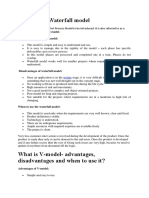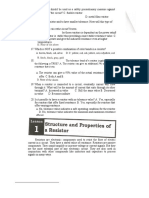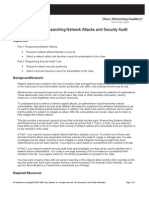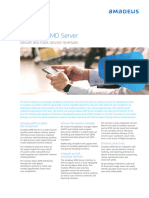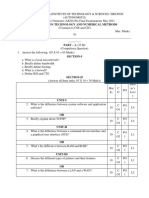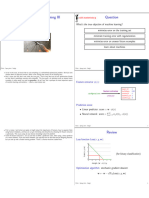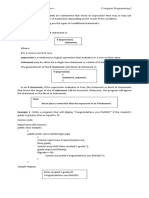Grade
TLE- ICT
COMPUTER PROGRAMMING I
QUARTER 3 – MODULE 3
SOFTWARE DEVELOPMENT LIFE CYCLE MODELS
Prepared by:
MARIA CRISTINA A. MALONG
Teacher I
Bautista National High School
0
� What Do You Need To Know?
I. INTRODUCTION
The following are the topics to be discussed in this module -
- Spiral Model
- Agile Model
- RAD Model
II. MODULE CONTENT
SDLC MODELS
Spiral Model
The spiral model is one of the most important SDLC models, which provides support for risk
handling. It is a combination of the iterative development process model and the waterfall
model as a sequential linear development model. It allows incremental releases of the
product through each iteration around the spiral. The spiral model was first mentioned by
Barry Boehm in his 1986 paper.
PHASES OF THE SPIRAL MODEL
[https://www.geeksforgeeks.org/software-engineering-spiral-model/?ref=lbp]
Each loop of the spiral is the phases of the software development process. The number of
phases for developing a product can be varied on some constraints and by project manager
which calculates the project risks. The following are the phases of Spiral model divided into
four quadrants -
1. Objectives determination and identify alternative solutions or Planning Phase
In this software development phase, requirements are gathered from the customers
and the objectives are identified, elaborated and analyzed at the start of every phase.
2. Identify and resolve risks
1
� During this phase, all the possible solutions are assessed and the best one gets
selected. Then, any type of risks linked with the chosen solution are identified and
resolved using the best possible strategy. At the end of this phase, a project
prototype is produced. (Prototype is an early sample release of the product built to
test the concept of the product under development. It is an incomplete version of the
product being developed.)
3. Develop next version of the product
As the development progresses, the required features are developed and verified
through testing. At the end of this phase, the next version of the software is available
and ready to deliver.
4. Review and plan for the next phase
The customer evaluates the developed version of the product and reports if any
changes are required. Planning for the next phase is started.
ADVANTAGES OF SPIRAL MODEL
- Risk handling. The Spiral model is the best development model to follow due to risk
analysis and risk handling at every phase.
- Customer satisfaction. The customer can see the development of the product at
every stage and thus, they can let themselves familiar with the system and give
feedbacks accordingly before the final product is made.
- Requirements flexibility. Any requirements needed at later phases can be included
accurately by using this model.
- Suitable for large projects. When a project is large or complex to develop, spiral
model is a good choice.
DISADVANTAGES OF SPIRAL MODEL
- Expensive. Therefore, it is not suitable for small projects.
- Management is more complex as well as the process.
- End of the project may not be known early.
- Too much dependable on risk analysis. Without highly experienced expertise, it is
difficult to develop a project using this model and may end up a failure.
AGILE MODEL
The Agile Software Development Life Cycle model focuses on process adaptability and
customer satisfaction by rapid delivery of working software product. Hence, aims to facilitate
quick project completion. To attain this task, agility is required. Activities that may not be
essential for the project are eliminated, thus saves time and effort in the process.
Agile model refers to a group of development processes. The following are some of the Agile
SDLC models:
- Crystal
- SCRUM
- XP (Extreme Programming)
- Unified Process
- Feature-driven Development
- Lean Development
PHASES OF THE AGILE SDLC MODEL
2
�Agile model is a combination of the iterative development and the incremental process model.
The requirements are classified into many small parts that can be incrementally developed.
Each increment is developed over an iteration and each iteration is intended to be small and
manageable and that can be completed within two to three weeks only.
Once all the iterations are completed, it is displayed to the customer and other stakeholders
for approval and acceptance of the final product.
Principles of Agile Model:
-Individuals and interactions. The competent team members.
Having the right group of individuals on your software development team is a vital to success.
The interaction between team members are what helps them collaborate and solve any
problems that may rise.
-Working software. Frequent delivery of incremental versions of the software to the customer
helps to improve the software development team’s future releases.
-Customer Collaboration. The focus should be on continuous development and that comes
with continuous interaction with the customer. You need to build a feedback loop with your
customers so that you can constantly ensure that your product works for them.
-Responding to change. Requirement change requests from the customer are
encouraged and efficiently incorporated.
ADVANTAGES OF AGILE MODEL
-Delivers early partial working solutions. Providing updates to customers after each iteration.
-Promotes teamwork and cross training
-Functionality can be developed rapidly and demonstrated
-Suitable for changing requirements
-Gives flexibility to developers
3
�-Reduces total development time of the project
-Minimal rules, documentation easily employed.
DISADVANTAGES OF AGILE MODEL
-Not suitable for handling complex dependencies
-More risk of sustainability and maintainability
-Strict delivery management
-Depends on customer interaction. If the customer is not clear, then the team can be driven in
a wrong decision.
-Due to lack of proper documentation, maintenance of the developed project can be a problem
if the developers are not available or assigned to another project.
Rapid Application Development (RAD) MODEL
The RAD model was proposed by IBM in 1980’s. Its concept is based on both prototyping
and iterative development model. Using the RAD methodology, the software project is
broken down into modules wherein each module is developed simultaneously by separate
team thus, saves development time. These modules are then combined to form a final
product.
Elicit
Requirements
Modularize
Requirements
Analyze
Team 1 Team 2 Team N
Design
Develop Develop Develop
. . . . Module N Code
Module 1 Module 2
Test
Integrate all
the modules
Test the final
product and
deliver
The development of each module has the following basic steps as in waterfall model, the
analyzing, designing, coding and then testing. It consists of the following phases:
1. Requirements Planning. Various techniques are used in gathering requirements like
brainstorming, task analysis, form analysis, user scenarios, etc. It also consists of the entire
structured plan describing the critical data, the methods used in obtaining it and then
processing it to form final refined model.
4
�2. User Description. Includes re-examination and validation of the gathered data from the
requirements phase in taking feedbacks from the user. Then, with the use of development
tools, a prototype is created.
3. Construction. Refinement of the prototype, coding and delivery of the final working
product takes place in this phase. Any modifications and enhancements are applied in this
phase.
4. Cutover. Testing is done in this phase. All the interfaces between modules developed
separately by teams have to be tested properly and then followed by a user acceptance
testing.
The process comprises of building rapid prototype, delivering it to the customer, taking
feedbacks and validating it. After validation, an SRS document is developed and the design
is finalized.
ADVANTAGES OF RAD MODEL
- Reusability of components speeds up the development
- Dividing the project into modules makes the development task easier
- Changing requirements can be accommodated.
- Encourages customer feedback.
- Integration from very beginning solves a lot of integration issues.
DISADVANTAGES OF RAD MODEL
- Only system that can be modularized can be built using RAD.
- Requires highly skilled developers/designers.
- Requires user involvement throughout the life cycle.
- Not meant for small scale projects
- Suitable for project requiring shorter development times.
III. ACTIVITIES
A. TAG ME!
Directions: Label the parts of the following software life cycle model: (20pts)
1.Spiral Model (5 pts)
2.
1.
4.
3.
5
�2. RAD Model (10 pts)
1
3
Team 1 Team 2 Team N
4
Develop Develop Develop
. . . . Module N 5
Module 1 Module 2
6
3. Agile Model (5 pts)
1 3
5 4
B. ENUMERATION (5 pts)
1. Give two advantages and disadvantages of the Spiral Model.
2. Give two advantages and disadvantages of the RAD Model.
3. Give one advantage and disadvantage of the Agile Model
6
�IV. SUMMATIVE ASSESSMENT
TEST I. IDENTIFICATION
Directions: Identify the word/s being described in each item. Choose the answer
from the box below. Write your answer on a separate sheet of paper.
Agile Model Identify and resolve risks Phase Individuals and interactions
Spiral Model Develop next version of the product Customer Collaboration
Planning Phase Review and plan for the next phase Responding to change
RAD model Working software Customer Satisfaction
1. A phase in spiral model in which all the possible solutions are assessed and the best
solution is chosen. Any risks linked to the chosen solution is then identified and resolved
2. Any change in the customer’s requirements are entertained and efficiently incorporated.
3. An SDLC model that focuses on process adaptability and customer satisfaction by rapid
delivery of working software product.
4. Building a feedback loop with the customer is important to ensure that the customer’s
expectations are achieved.
5. Having the right group of individuals working as team is a vital to success.
6. Frequent delivery of incremental versions of the software to the customer helps to improve
the software development team’s future releases.
7.The communication between team members is what helps them to solve any problems that
may rise during the software development.
8. This SDLC model was first proposed by IBM in 1980’s.
9. This SDLC model was first mentioned by Barry Boehm in his 1986 paper.
10. As the development progresses, the required features are developed and verified through
testing. At the end of this phase, the next version of the software is available and ready to
deliver.
TEST II. TRUE or FALSE
Directions: Write T if the statement is correct and F if it states falsity. Answer on a
separate sheet of paper.
1. One of the advantages of RAD model is the reusability of components which speeds up the
development of the project.
2. The Spiral model focuses on process adaptability and customer satisfaction by rapid
delivery of working software product.
3. The spiral model provides support for risk handling.
4. Implementing the spiral methodology is expensive yet it is also suitable for small projects.
5. The customer’s feedback is not important in any SDLC model.
7
� TEST III.
Directions: Explain the Agile Software Development Life Cycle Model. (10pts)
Rubrics for the output:
10 7 4 1
The answer provides a The answer provides a The Agile model The answer lacks
complete detail of the complete detail of the phases are identified substance about
Agile model phases with Agile model phases with but is poorly the topic..
accurate explanations. less explanations and explained.
needs improvement.
KEY TO CORRECTION
1. Activity 1. TAG ME!
Spiral Model
1. Objectives determination and identify alternative solutions or Planning
Phase
2.Identify and resolve risks
3. Develop next version of the product
4. Review and plan for the next phase
RAD Model
1. Elicit Requirements
2. Modularize requirements
3. Analyze
4. Design
5. Code
6. Test
7. Integrate all the modules
8. Test the final product and deliver
Agile Model
1. Planning
2. Requirements Analysis
8
� 3. Design
4. Development
5. Testing
6. Release
B.
Answers may vary.
REFERENCES:
SDLC: Phases & Models of Software Development Life Cycle (guru99.com)
https://www.tutorialspoint.com/sdlc/index.htm
https://www.roberthalf.com.au/blog/employers/6-basic-sdlc-methodologies-which-one-best
https://www.w3schools.in/sdlc-tutorial/spiral-model/
https://www.geeksforgeeks.org/software-engineering-spiral-model/?ref=lbp
https://www.w3schools.in/sdlc-tutorial/agile-model/
https://www.productboard.com/glossary/agile-
values/#:~:text=The%20Agile%20Manifesto%20consists%20of,Customer%20collaboration%20over%
20contract%20negotiation.
https://www.javatpoint.com/agile-sdlc
https://www.w3schools.in/sdlc-tutorial/agile-model/
https://www.geeksforgeeks.org/software-engineering-agile-development-models/?ref=rp
https://www.tutorialspoint.com/sdlc/sdlc_agile_model.htm
https://www.guru99.com/agile-scrum-extreme-testing.html
https://www.geeksforgeeks.org/software-engineering-rapid-application-development-model-rad/
https://www.w3schools.in/sdlc-tutorial/rad-model/#
https://www.tutorialspoint.com/sdlc/sdlc_rad_model.htm






